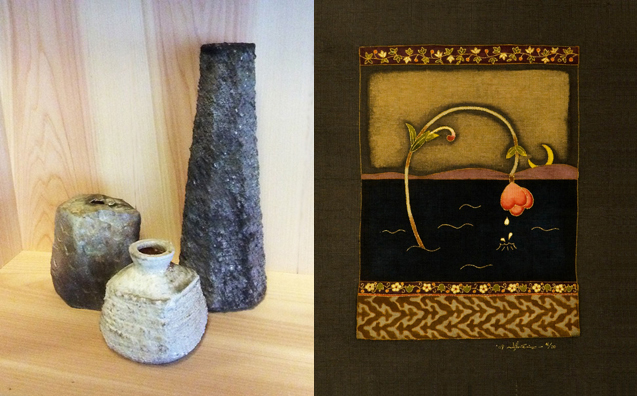
April Exhibition Dual Exhibition of Japanese Artists Tatsuo Sagane & Yukiharu Nihei April 10th - 23rd, 2014
|
 |
|
|---|---|---|
In April, NY Coo Gallery will present a Two-Person Exhibition of Japanese Artists, Tatsuo Sagane and Yukiharu Nihei, organized by NY Coo Gallery & Magnolia NY. Tatsuo Sagane His style is bold yet delicate. His hands while kneading clay and spirit in coming to face with nature consistently remain pure and humble, consequently robust. In his pottery, his stance to gently yet rigorously watch over the phenomena of nature is revealed. He insistently fires his pottery in his traditional anagama kiln he built, which creates striking natural surfaces from the natural ash glaze. In his single-chamber anagama kiln, Saganefs spirit fuses with all the elements of nature, clay, fire, wood, and air, to become his expression. In Saganefs 2008 and 2010 exhibitions in New York, incorporating Saganefs works into everyday life gave pleasure and contentment to many. Please take this opportunity to enjoy Saganefs pottery and come in contact with his expression. Saganefs anagama kiln Yukiharu Nihei While Niheifs two previous 2012 and 2013 exhibitions in New York focused on works on paper, this exhibition features works both on silk and paper. In his works on silk, he depicts the narrative of a humorous tale that unfolds in a moonlit night utilizing deep heart-warming colors through his skillful dyeing techniques. The works on paper are abstract spiritual expressions inspired by Chinese brush paintings and traditional Japanese calligraphy. According to Yukiharu Nihei, gI want to create something which brings genuine insight to appreciate the beauty of nature -- the color of the sky, the ripple in the water, leaves on the trees, the fragrance in the breeze | and life more fully to the viewer of my art work and that is the power of creation, I believe.h This exhibition will offer a rare opportunity to see the resonance between pottery and painting demonstrating a rich cultural heritage. We look forward to seeing you at the exhibition. Niheifs dyeing techniques gItomeh(means threadlike line in Japanese) is the white outline left in the design after the dyeing process is completed. *Roketsu-zome is a traditional wax-resist dyeing technique in Japan, akin to Indonesian batik.
Necklaces by TOPPI (Ëò) NYCfs Hitoshi Nakazato Series. Hitoshi Nakazato, my beloved late husband, was a contemporary artist who is known for his conceptual non-representational geometric paintings and prints. A recent session of an on-going effort to photograph his works allowed me to immerse myself in his color pallet and painterly application of acrylic on canvas and panels. In my Hitoshi Nakazato Series, Ifve attempted to interpret some of Hitoshifs signature icons in my necklaces: asymmetry; juxtaposition of different visual elements on the right and left sides; cutting up space into 1/4 s; paying tribute to Sengai late 18th century Japanese Zen monk and artist who painted primary shapes before the European avant-garde; persistent use of black carbon sand. I hope find the results provocative and Toppi. Sumi Nakazato |
||
|
||
| NY Coo Gallery |
